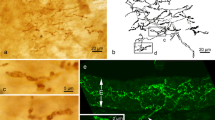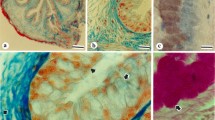Abstract
Grandry corpuscles in the oral mucosa of the upper bill of the duck were immunohistochemically studied using antisera against calcitonin gene-related peptide (CGRP), galanin, methionine-enkephalin, neuropeptide Y (NPY), somatostatin, substance P (SP) and vasoactive intestinal peptide (VIP). Grandry corpuscles in the lamina propria selectively showed only SP-like immunoreactivity. Herbst corpuscles distributed near Grandry corpuscles were negative to all antisera applied. Although immunoreactive products in the Grandry corpuscles were found as granules in the peripheral cytoplasm of the Grandry cell, the axon terminals and satellite cells exhibited no reactivity. In pre-embedding electron-microscopic sections, SP-like immunoreactive products visualized with 3,3′-diaminobezidine were localized in the granules of Grandry cells, but no labeling was observed in the cytoplasmic matrix or cell organelles. Electron-immunocytochemical labeling with colloidal gold by the post-embedding method clearly demonstrated that the SP antigen was localized only in the granules. It is presumed that Grandry cells have a secretory function. However, the function and the method of release of the SP contained in the observed granules remains obscure. Some CGRP-, NPY-, SP- and VIP-like-immunoreactive nerve fibers with varicosities associated with blood vessels and nerve fiber bundles of various sizes were observed in the lamina propria, but no such fibers penetrated into the intraepitherial layer. Nerve fibers positive for SP and VIP were also found in the interlobular connective tissue of the palatine glands. Some SP-positive neurons were detected in the vicinity of the palatine glands.
Similar content being viewed by others
References
Alvarez FJ, Cervantes C, Villalba R, Blasco I, Martínez-Murillo R, Polak JM, Rodrigo J (1988) Immunocytochemical analysis of calcitonin gene-related peptide and vasoactive intestinal polypeptide in Merkel cells and cutaneous free nerve endings of cats. Cell Tissue Res 254:429–437
Cheng Chew SB, Leung PY (1991) Immunocytochemical evidence of a met-enkephalin-like substance in the dense-core granules of mouse Merkel cells. Cell Tissue Res 265:611–614
Cheng Chew SB, Leung PY (1992) Species variability in the expression of met- and leu-enkephalin-like immunoreactivity in mammalian Merkel cell dense-core granules. A light- and electron-microscopic immunohistochemical study. Cell Tissue Res 269:347–351
Diamond J, Holmes M, Nurse CA (1986) Are Merkel cell-neurite reciprocal synapses involved in the initiation of tactile responses in salamander skin? J Physiol (Lond) 376:101–120
English KB, Wang ZZ, Stayner N, Stensaas LJ, Martin H, Tuckett RP (1992) Serotonin-like immunoreactivity in Merkel cells and their afferent neurons in touch domes from the hairy skin of rats. Anat Rec 232:112–120
García-Caballero T, Gallego R, Rosón E, Basanta D, Morel G, Beiras A (1989a) Localization of serotonin-like immunoreactivity in the Merkel cells of pig snout skin. Anat Rec 225:267–271
García-Caballero T, Gallego R, Rosón E, Fraga M, Beiras A (1989b) Calcitonin gene-related peptide (CGRP) immunoreactivity in the neuroendocrine Merkel cells and nerve fibres of pig and human skin. Histochemistry 92:127–132
Gauweiler B, Weihe E, Hartschuh W, Yanaihara N (1988) Presence and coexistence of chromogranin A and multiple neuropeptides in Merkel cells of mammalian oral mucosa. Neurosci Lett 89:121–126
Gottschaldt KM, Lausmann S (1974) Mechanoreceptors and their properties in the beak skin of geese (Anser anser). Brain Res 65:510–515
Gottschaldt KM, Vahle-Hinz C (1981) Merkel cell receptors: structure and transducer function. Science 214:183–186
Gottschaldt KM, Vahle-Hinz C (1982) Evidence against transmitter function of Met-enkephalin and chemosynaptic impulse generation in “Merkel cell” mechanoreceptors. Exp Brain Res 45:459–463
Halata Z (1971) Ultrastructure of Grandry nerve endings in the beak skin of some aquatic birds. Folia Morphol 19:225–232
Hartschuh W, Weihe E (1980) Fine structural analysis of the synaptic junction of Merkel cell-axon-complexes. J Invest Dermatol 75:159–165
Hartschuh W, Weihe E (1988) Multiple messenger candidates and marker substances in the mammalian Merkel cell-axon complex: a light and electron microscopic immunohistochemical study. Prog Brain Res 74:181–187
Hartschuh W, Weihe E, Büchler M, Helmstaedter V, Feurle GE, Forssmann WG (1979) Met-enkephalin-like immunoreactivity in Merkel cells. Cell Tissue Res 201:343–348
Hartschuh W, Weihe E, Yanaihara N, Reinecke M (1983) Immunohistochemical localization of vasoactive intestinal polypeptide (VIP) in Merkel cells of various mammals: evidence for a neuromodulator function of the Merkel cell. J Invest Dermatol 81:361–364
Hartschuh W, Weihe E, Yanaihara N (1989) Immunohistochemical analysis of chromogranin A and multiple peptides in the mammalian Merkel cell: further evidence for its paraneuronal function? Arch Histol Cytol 52:[Suppl]:423–431
Horch KW, Whitehorn D, Burgess PR (1974) Impulse generation in type I cutaneous receptors. J Neurophysiol 37:267–281
Idé C, Munger BL (1978) A cytologic study of Grandry corpuscle development in chicken toe skin. J Comp Neurol 179:301–324
Iggo A, Muir AR (1969) The structure and function of a slowly adapting touch corpuscle in hairy skin. J Physiol (Lond) 200:763–796
Leitner LM, Roumy M (1974) Mechanosensitive units in the upper bill and in the tongue of the domestic duck. Pflüger Arch 346:141–150
Malinovsky L (1967) Die Nervenendkörperchen in der Haut von Vögeln und ihre Variabilität. Z Mikrosk Anat Forsch 77:279–303
Mearow KM, Diamond J (1988) Merkel cells and the mechanosensitivity of normal and regenerating nerves in Xenopus skin. Neuroscience 26:695–708
Munger BL (1971) Patterns of organization of peripheral sensory receptors. In: Autrum H, Jung R, Loewenstein WR, Mackay DM, Teuber HL (eds) Handbook of sensory physiology, vol 1. Springer, Berlin Heidelberg New York, pp 523–556
Munger BL, Idé C (1988) The structure and function of cutaneous sensory receptors. Arch Histol Cytol 51:1–34
Pubols LM, Pubols BH, Munger BL (1971) Functional properties of mechanoreceptors in glabrous skin of raccoon's forepaw. Exp Neurol 31:165–182
Quilliam TA (1966) Structure of receptor organs. Unit design and array patterns in receptor organs. In: Reuck AVS, Knight J (eds) Touch, heat and pain. Churchill, London, pp 86–116
Saxod R (1968) Ultrástructure des corpuscules sensoriels cutanés de Herbst et de Grandry chez le canard. Arch Anat Microsc Morphol Exp 57:379–400
Saxod R (1970) Etude au microscope électronique de l'histogenèse du corpuscule sensoriel cutané de Grandry chez le canard. J Ultrastruct Res 32:477–496
Saxod R (1972) Rôle du nerf et du territoire cutané dans le développement des corpuscles de Herbst et de Grandry. J Embryol Exp Morphol 27:277–300
Saxod R (1978) Development of cutaneous sensory receptors in birds. In: Jacobson M (ed) Handbook of sensory physiolo vol. 9. Development of sensory system. Springer, Berlin heidelberg New York, pp 337–417
Saxod R (1980) Development of Merkel corpuscles in the chicken beak. The problem of their origin and identity. Biol Cell 37:61–66
Scott SA, Cooper E, Diamond J (1981) Merkel cells as targets of the mechanosensory nerves in salamander skin. Proc R Soc Lond [Biol] 211:455–470
Toyoshima K (1993) Are Merkel and Grandry cells two varieties of the same cell in birds?. Arch Histol Cytol 56:167–175
Weihe E, Hartschuh W, Nohr D (1991) Light microscopic immunoenzyme and electron microscopic immunogold cytochemistry reveal tachykinin immunoreactivity in Merkel cells of pig skin. Neurosci Lett 124:260–263
Author information
Authors and Affiliations
Rights and permissions
About this article
Cite this article
Kumamoto, K., Ebara, S., Fukuda, F. et al. Immunohistochemistry of Grandry corpuscles in the oral mucosa of the duck bill: a light- and electron-microscopic study. Cell Tissue Res 280, 253–258 (1995). https://doi.org/10.1007/BF00307796
Received:
Accepted:
Issue Date:
DOI: https://doi.org/10.1007/BF00307796




